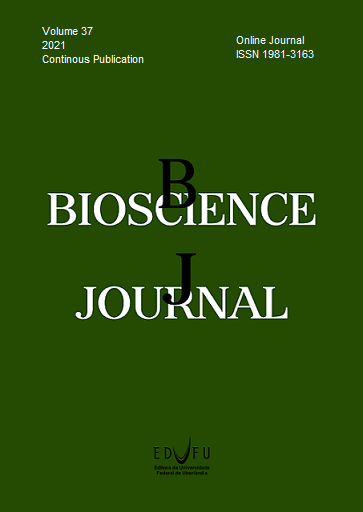Agronomic and sensory evaluation of lettuce in hydroponic system
DOI:
https://doi.org/10.14393/BJ-v37n0a2021-53765Keywords:
Color, Hydroponics, Lactuca sativa L. sensory evaluationAbstract
Lettuce is the most important leafy vegetable in Brazil. Hydroponic lettuce cultivation has grown due to the viability of harvesting throughout the year. In this context, this study aimed to evaluate the agronomic characteristics, color, and preference of curly lettuce in the NFT hydroponic system. Six lineages (6601-1A, 6601-2L, 7016-6A, 7119-1B, 7223-1A, and 7224-4A) and two commercial cultivars (Brida and Vanda) of lettuce were used, in a completely randomized blocks design with four replications. Shoot length, root length, stem length, number of leaves, stem diameter, plant diameter, shoot fresh mass, root fresh mass, chlorophyll content, instrumental color, and sensory characteristics were evaluated. As for agronomic evaluation, the bolting of 6601-2L lettuce was relevant in different attributes. The Vanda lettuce and the lineage 7016-6A presented best performances for shoot fresh mass (399.44 and 378.63 g, respectively), while the lineages 7119-1B and 6601-2L present the worst performance (279.50 and 273.13 g, respectively). There was variation in chlorophyll content and luminosity, however, the evaluators did not notice differences between lettuces for brightness or green color, as well as for crunchy texture. Lettuces 6601-2L, 7224-4A, 6601-1A, Brida, 7223-1A, and 7119-1B were preferred. The variation among plants may be due to different situations, such as harvesting times and bolting, and a direct relationship between agronomic properties and preference among lettuces has not been established yet.
References
Associação Brasileira de Normas Técnicas [ABNT]. Teste de ordenação em análise sensorial. Rio de Janeiro: Associação Brasileira de Normas Técnicas, 1994.
BARBOSA, J.C. and MALDONADO JÚNIOR, W. Experimentação agronômica & AgroEstat: Sistema para análises estatísticas de ensaios agronômicos. 1st ed. Jaboticabal: Fundação de Apoio a Pesquisa, Ensino e Extensão (FUNEP), 2015.
BLIND, A.D. and SILVA FILHO, D.F. Desempenho de cultivares de alface americana cultivadas com e sem mulching em período chuvoso da Amazônia. Revista Agroambiente On line. 2015, 9(2), 143-151. http://dx.doi.org/10.18227/1982-8470ragro.v9i2.2183
FILGUEIRA, F.A.R. Novo Manual de Olericultura: agrotecnologia moderna na produção e comercialização de hortaliças. 2nd ed. Viçosa: UFV, 2003.
FONTANA, L., et al. Physicochemical characterization and sensory evaluation of lettuce cultivated in three growing systems. Horticultura Brasileira. 2018, 36(1), 20-26. https://doi.org/10.1590/s0102-053620180104
FURLANI, P.R., SILVEIRA, L.C.P., BOLONHEZI, D. and FAQUIN, V. Cultivo hidropônico de plantas. Campinas: Instituto Agronômico, 1999.
LIMA, T.J.L., et al. Volume of cells on trays influences hydroponic lettuce production. Horticultura Brasileira. 2018, 36, 408-413. https://doi.org/10.1590/s0102-053620180320
LONGATTI, B.F., et al. Avaliação agronômica de cultivares de alface em cultivo hidropônico. Horticultura Brasileira. 2014, 31, S0900-S0906.
LUZ, A.O., SOUZA, S.B.S. and NASCIMENTO, A.S. Resistência ao pendoamento de genótipos de alface em ambientes de cultivo. Agrarian. 2009, 2(6), 71-82.
LUZ, J.M.Q., GUIMARÃES, S.T.M.R. and KORNDÖRFER, G.D. Produção hidropônica de alface em solução nutritiva com e sem silício. Horticultura Brasileira. 2006, 24(3), 295-300. https://doi.org/10.1590/S0102-05362006000300005. ISSN 1806-9991
McWATTERS, Lk.H., et al. Consumer acceptance of fresh-cut iceberg lettuce treated with 2% hydrogen peroxide and mild heat. Journal of Food Protection. 2002, 65(8), 1221-1226. https://doi:10.4315/0362-028x-65.8.1221
MENEGAES, J.F., FILIPETTO, J.E., RODRIGUES, A.M. and SANTOS, O.S. Produção sustentável de alimentos em cultivo hidropônico. Revista Monografias Ambientais. 2015, 14(3), 102-118.
MINOLTA CORP. Chlorophyll meter SPAD-502Plus: A lightweight handheld meter for measuring the chlorophyll content of leaves without causing damage to plants. Osaka: Minolta Corp. Ltda., 2009.
MINOLTA CORP. Precise Color Communication: color control from feeling to instrumentation. Osaka: MINOLTA Corp. Ltda., 2007.
NEWELL, G.J. and MacFARLANE, J.D. Expanded tables for multiple comparison procedures in the analysis of ranked data. Journal of Food Science. 1987, 52(6), 1721-1725. https://doi.org/10.1111/j.1365-2621.1987.tb05913.x
OLIVEIRA, A.C.B., et al. Divergência genética e descarte de variáveis em alface cultivada sob sistema hidropônico. Acta Scientiarum. 2004, 26(2), 211-217.
SALA, F.C. and COSTA, C.P. Retrospectiva e tendência da alfacicultura brasileira. Horticultura Brasileira. 2014, 30, 187-194. https://doi.org/10.1590/S0102-05362012000200002
SANCHES, C.E., ARAÚJO, J.A.C., SPELLING, A.C., and VILLELA JUNIOR, L.V.E. Cultivo hidropônico da alface do grupo americana com resfriamento da solução nutritiva. Jaboticabal: Congresso Brasileiro de Olericultura, 2005. Available from: http://www.abhorticultura.com.br/biblioteca/arquivos/Download/Biblioteca/44_244.pdf
SANTOS, A.N., et al. Cultivo hidropônico de alface com água salobra subterrânea e rejeito da dessalinização em Ibimirim, PE. Revista Brasileira de Engenharia Agrícola e Ambiental. 2014, 14(9), 961-969. https://doi.org/10.1590/S1415-43662010000900008
SAS, Institute INC. Sas user’s guide for Windows environment. Cary: SAS Institute, 2005.
SEDIYAMA, M.A.N. Desempenho de cultivares de alface para cultivo hidropônico no verão e no inverno. Científica. 2009, 2(37), 98-103.
SILVA, D.F.P., et al. Produção de mini alface em cultivo hidropônico. Científica. 2015, 8(1), 75-86.
VICENTINI-POLETTE, C.M., et al. Avaliação das características físico-químicas e aceitação da alface Crocantela produzida em sistema hidropônico na cidade de Araras, São Paulo. DEMETRA: Alimentação, Nutrição & Saúde. 2018, 13(3), 663-673. https://doi.org/10.12957/demetra.2018.31509
VITAL, W.M., et al. Comportamento de variedades de alface (Lactuca sativa L.) cultivadas em hidroponia com diferentes soluções nutritivas. Ecossistema. 2002, 27(1), 2.
Downloads
Published
Issue
Section
License
Copyright (c) 2021 Jean Jefferson de Sá, Carolina Medeiros Vicentini-Polette, Marta Regina Verruma-Bernardi, Marta Helena Fillet Spoto, Fernando César Sala

This work is licensed under a Creative Commons Attribution 4.0 International License.





